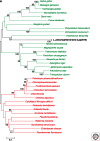Genome dynamics in Legionella: the basis of versatility and adaptation to intracellular replication
- PMID: 23732852
- PMCID: PMC3662349
- DOI: 10.1101/cshperspect.a009993
Genome dynamics in Legionella: the basis of versatility and adaptation to intracellular replication
Abstract
Legionella pneumophila is a bacterial pathogen present in aquatic environments that can cause a severe pneumonia called Legionnaires' disease. Soon after its recognition, it was shown that Legionella replicates inside amoeba, suggesting that bacteria replicating in environmental protozoa are able to exploit conserved signaling pathways in human phagocytic cells. Comparative, evolutionary, and functional genomics suggests that the Legionella-amoeba interaction has shaped this pathogen more than previously thought. A complex evolutionary scenario involving mobile genetic elements, type IV secretion systems, and horizontal gene transfer among Legionella, amoeba, and other organisms seems to take place. This long-lasting coevolution led to the development of very sophisticated virulence strategies and a high level of temporal and spatial fine-tuning of bacteria host-cell interactions. We will discuss current knowledge of the evolution of virulence of Legionella from a genomics perspective and propose our vision of the emergence of this human pathogen from the environment.
Figures




Similar articles
-
Molecular Mimicry: a Paradigm of Host-Microbe Coevolution Illustrated by Legionella.mBio. 2020 Oct 6;11(5):e01201-20. doi: 10.1128/mBio.01201-20. mBio. 2020. PMID: 33024033 Free PMC article. Review.
-
Legionnaires' Disease: State of the Art Knowledge of Pathogenesis Mechanisms of Legionella.Annu Rev Pathol. 2020 Jan 24;15:439-466. doi: 10.1146/annurev-pathmechdis-012419-032742. Epub 2019 Oct 28. Annu Rev Pathol. 2020. PMID: 31657966 Review.
-
Adaptation of Legionella pneumophila to the host environment: role of protein secretion, effectors and eukaryotic-like proteins.Curr Opin Microbiol. 2006 Feb;9(1):86-94. doi: 10.1016/j.mib.2005.12.009. Epub 2006 Jan 6. Curr Opin Microbiol. 2006. PMID: 16406773 Review.
-
Legionella pneumophila adaptation to intracellular life and the host response: clues from genomics and transcriptomics.FEBS Lett. 2007 Jun 19;581(15):2829-38. doi: 10.1016/j.febslet.2007.05.026. Epub 2007 May 21. FEBS Lett. 2007. PMID: 17531986 Review.
-
Intracellular parasitism, the driving force of evolution of Legionella pneumophila and the genus Legionella.Genes Immun. 2019 May;20(5):394-402. doi: 10.1038/s41435-019-0074-z. Epub 2019 May 4. Genes Immun. 2019. PMID: 31053752 Review.
Cited by
-
Biological Diversity and Evolution of Type IV Secretion Systems.Curr Top Microbiol Immunol. 2017;413:1-30. doi: 10.1007/978-3-319-75241-9_1. Curr Top Microbiol Immunol. 2017. PMID: 29536353 Free PMC article.
-
Targeting of host organelles by pathogenic bacteria: a sophisticated subversion strategy.Nat Rev Microbiol. 2016 Jan;14(1):5-19. doi: 10.1038/nrmicro.2015.1. Epub 2015 Nov 23. Nat Rev Microbiol. 2016. PMID: 26594043 Review.
-
Microbial warfare in the wild-the impact of protists on the evolution and virulence of bacterial pathogens.Int Microbiol. 2021 Nov;24(4):559-571. doi: 10.1007/s10123-021-00192-y. Epub 2021 Aug 8. Int Microbiol. 2021. PMID: 34365574 Review.
-
Differences in Virulence Between Legionella pneumophila Isolates From Human and Non-human Sources Determined in Galleria mellonella Infection Model.Front Cell Infect Microbiol. 2018 Apr 4;8:97. doi: 10.3389/fcimb.2018.00097. eCollection 2018. Front Cell Infect Microbiol. 2018. PMID: 29670859 Free PMC article.
-
Comparative Genomics of Legionella pneumophila Isolates from the West Bank and Germany Support Molecular Epidemiology of Legionnaires' Disease.Microorganisms. 2023 Feb 10;11(2):449. doi: 10.3390/microorganisms11020449. Microorganisms. 2023. PMID: 36838414 Free PMC article.
References
-
- Andersson SG, Zomorodipour A, Andersson JO, Sicheritz-Pontén T, Alsmark UC, Podowski RM, Näslund AK, Eriksson AS, Winkler HH, Kurland CG 1998. The genome sequence of Rickettsia prowazekii and the origin of mitochondria. Nature 396: 133–140 - PubMed
-
- Atlan D, Coupat-Goutaland B, Risler A, Reyrolle M, Souchon M, Briolay J, Jarraud S, Doublet P, Pélandakis M 2012. Micriamoeba tesseris nov. gen. nov. sp: A new taxon of free-living small-sized Amoebae non-permissive to virulent Legionellae. Protist 163: 888–902 - PubMed
-
- Berger KH, Isberg RR 1993. Two distinct defects in intracellular growth complemented by a single genetic locus in Legionella pneumophila. Mol Microbiol 7: 7–19 - PubMed
-
- Bruggemann H, Cazalet C, Buchrieser C 2006. Adaptation of Legionella pneumophila to the host environment: Role of protein secretion, effectors and eukaryotic-like proteins. Curr Opin Microbiol 9: 86–94 - PubMed
Publication types
MeSH terms
Substances
LinkOut - more resources
Full Text Sources
Other Literature Sources
Molecular Biology Databases
